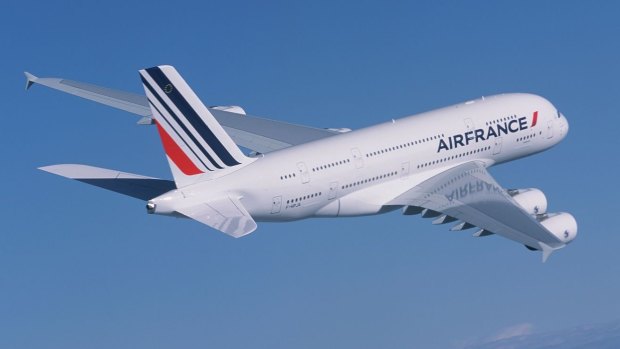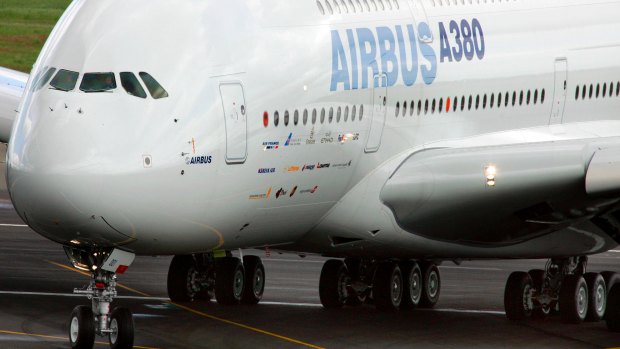This was published 4 years ago
Airbus A380 superjumbo: Air France to ditch world's biggest airliner
By Oliver Smith

Air France has abandoned plans to renovate its A380s and will now ditch its entire fleet of 10 superjumbos by 2022.Credit: AIRBUS
Air France has announced plans to ditch its entire fleet of 10 Airbus A380s in the latest blow to the future of the world's largest passenger plane.
Last year the airline said it would not renew the leases on five of its 10 "superjumbos", but that five others would be renovated at a cost of around $US45 million ($A67 million) per aircraft. Now it has scrapped the upgrades and will retire all 10 jets by 2022.
The travails of the A380, which can hold more than 600 passengers in a two-class seating configuration, have become something of an aviation soap opera in recent years. The model was launched to much fanfare in 2005 with many declaring it the future of air travel.

The world's largest passenger aircraft fell out of favour with airlines just 10 years after its launch.Credit: AP
But airlines were harder to convince and sales slowly ground to a halt. Just two new orders were received in 2015 and none in either 2016 or 2017. In January 2018 Emirates, the A380's biggest customer, threw the superjumbo a lifeline with a fresh order – but this was cancelled in February 2019, prompting Airbus to start winding down the aircraft's production line.
Other operators have also been ejecting the A380 from their hangars. Earlier this year Lufthansa said six of its 14 A380s would be returned to Airbus by 2023. In 2017, Singapore Airlines returned two 11-year-old A380s to a German leasing company, Dr Peters Group.
Unfortunately for Airbus, the second-hand A380 market is hardly bouyant. Dr Peters Group stripped and sold for parts those two aircraft because it could not secure a new operator (British Airways was among those approached). In 2016 an Irish aircraft leasing company, Amedeo, said it was even considering creating its own airline because it couldn't find anyone to borrow its A380s.
See also: Scrapped: First A380 superjumbos to be broken up for parts
Why does nobody want the A380?
The jet has been widely praised by passengers for offering a smooth and comfortable flying experience, but commentators have called it a "vanity project" and the economics of operating it have proved off-putting for airlines. Simply put, every service needs to run at close to full capacity for carriers to make money.
Airlines are instead opting to buy medium-sized twin-engine planes, such as the Boeing 787 Dreamliner, the A320neo, which launched in 2016, and the A350, introduced in 2015. Air France uses the Boeing 777-300ER on many of its key long-haul routes. All these models are far easier to fill and cheaper to maintain than the A380.
Such is the popularity of the A320 that the company claims one takes off or lands somewhere in the world every two seconds. Airbus has previously said an A380 takes off or lands somewhere in the world every two minutes, but that is growing.
Its latest version, the A320neo, has received more than 6600 orders from around 70 airlines, making it the fastest-selling commercial aircraft in history.
"The A380 is well regarded by customers flying on it," explained air transport consultant John Strickland. "Generally, however, twin-engine aircraft such as the Airbus A350 and the Boeing 777 reduce the financial risks involved with filling capacity and operating costs."
Which airline owns the most A380s?
Emirates, by a long way. With a fleet of 112, it's one of the few carriers able to get any real value out of the four-engine A380, and has made it the core of its long-haul fleet. Other airlines have ordered them in far smaller quantities: Qantas has 12 A380s. British Airways also has 12 of them in its fleet of 277 aircraft.
See also: Airline review: Emirates A380 business class
Does it have a future?
Not a long-term one. Airbus has called time on the A380's production line, with the last outstanding order due for delivery in 2021. But aircraft typically have a lifespan of around 30 years, so the jet should be around for a while yet.
As mentioned above, there have been valiant efforts to create a second-hand market for A380s, but with little success. One of the more novel ideas came from Malaysia Airlines. Unable to sell or lease its six A380s, it has put forward plans to boost seating capacity to more than 700 and transfer them to a subsidiary carrier focused on religious pilgrimages.
At one point Airbus had also been hoping Chinese airlines would help revive it. China will be the world's biggest air travel market by 2022, according to the International Air Transport Association. But they too have been opting for smaller models, while 2008 saw the launch of Comac, a homegrown manufacturer that China hopes can break the Airbus-Boeing duopoly.
What's the next biggest passenger plane?
Hypothetically, should every single A380, capable of carrying 853 passengers in a single-class economy configuration, be grounded, the Boeing 747-800 would become the largest passenger aircraft in the world, capable of carrying 700 passengers in a single class.
But isn't the 747 falling from favour?
The 747 will remain in the sky for some time to come – a remarkable 1,554 have been built and delivered since 1966 - including four this year, all bound for cargo services - and they remain an important part of countless airline fleets, including that of British Airways, which owns 34 jumbo jets (more than any other carrier bar Atlas Air), and Virgin Atlantic, which has eight.
Little over 500 are still in service and the oldest "active" 747, according to the website Airfleets.net, made its maiden flight on July 13, 1969 (exactly one week before man first set foot on the moon) and belongs to Iran's Caspian Airlines.
But they are slowly being phased out. Qantas will phase out all its remaining 747s by the end of 2020. BA has retired two in the last nine months and said the model will be gone from its hangars by 2024. In 2017 United waved goodbye to its final 747, with a farewell flight from San Francisco to Honolulu (recreating the route of its first 747 service in 1970), as did its US rival Delta.
KLM has binned two in 2018. Before long this iconic aircraft, the world's biggest passenger plane for 37 years, will be the preserve of the planet's smaller airlines and cargo companies.
The Telegraph, London
Sign up for the Traveller newsletter
The latest travel news, tips and inspiration delivered to your inbox. Sign up now.